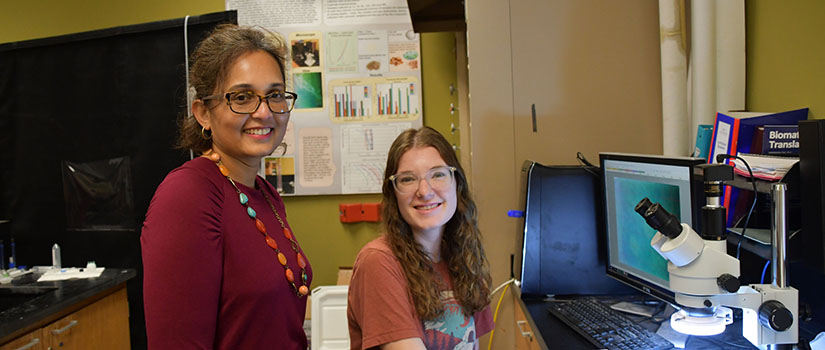Associate Professor Shamia Hoque always found herself teaching in her native Bangladesh. Whether teaching one or a group of students, those experiences led her to a career in academia. But she did not discover her passion for research until pursuing graduate studies in Canada.
“I could either work or look into other options. I felt graduate school would allow me to take a broader look and give me an opportunity to experience more instead of settling into a job,” Hoque says.
After earning her undergraduate degree in chemical engineering from Bangladesh University of Engineering and Technology, Hoque decided to pursue her master’s degree at the University of Toronto. She worked on environmental-related research under the chemical engineering umbrella, and one of her projects focused on slag, a leftover waste from iron ore used to treat snow covered roads.
“A lot of iron, cobalt and nickel remained in trace amounts in slag. The point of iron ore treatment was to take out those valuable materials before the slag formed. But since the materials were still there, it leached into the soil,” Hoque says.
Hoque’s project aimed to extract trace amounts of cobalt and nickel, but traditional treatment was not economically possible due to the small amounts of materials. Instead, she worked with her research mentor to develop a process of extracting the trace amounts using sulfurous acid produced on site. They also examined if a thermodynamic model could be developed to determine the amount that could be extracted and any limiting factors.
Hoque’s research experiences in Canada, her Ph.D. work at Drexel University and a one-year post-doctoral fellowship at the U.S. Environmental Protection Agency all influenced her current research activities in the Department of Civil and Environmental Engineering.
Hoque currently leads the BioAerosol Contaminant Transport and Control Technology BA (CT)2 Lab research group. The “2” is her own addition since most of the projects are divided into two groups. The first is aerosol transport, which refers to particle movement in air and water. Understanding how particles of different types of clay transform and transport is the focus of her current research project funded by the Department of Energy and led by the Savannah River National National Lab. The results will inform model development for emergency response for contaminant fate and transport.
“We could think about it as particle movement in water, and what happens if there's a sediment transport? If particles form clusters, how far it would travel, and where would it go if it carries a contaminant? The goal is to determine whether the particles will coalesce and form larger ones or break up and move elsewhere,” Hoque says.
The other group is best air control technology. A current two-year project in collaboration with colleagues Nicole Berge and Tanvir Farouk is focused on removing trace amounts of siloxane from landfill gas. Siloxane is a silicone-based compound found in creams and other products that is toxic and has potential negative health effects.
“We’re trying to collect the methane gas from landfills and transfer it and reuse it for electricity generation and combustion engines. But siloxane is a severe limiting factor,” Hoque says. “For example, dumping a shampoo bottle in a landfill releases siloxanes when it decays and erodes. Siloxane removal can be expensive, and if it remains, it breaks down into silica, which is essentially sand and results in deposits that can cause corrosion.”
Current methods for removing siloxane involve absorbing it into a material, but the absorbent is eventually reintroduced into the waste cycle. Hoque aims to use a non-thermal plasma system, which can transform siloxane to a solid deposit that can potentially become a raw material.
“We can transform the contaminant to a product which is a raw compound for another industry. By reusing it for something else, we take it entirely out of the waste cycle. We want to know how the process works to see if it has other applications,” Hoque says.
Hoque wants to further explore particle fate and transport and best air control technologies. But she admits that she first needs to determine the chemistry and process behind it. One of her research goals is to establish predictive integrated frameworks by informing models through coupling fundamental principles and experimental data. She hopes that her research will be utilized either by application or further insights to expand the knowledge base.
“There should be logical acceptance and interpretation from both sides, with the model and data speaking to each other and experts looking into why it's happening,” Hoque says. “If I can use the information and build my work, such as creating predictive models, how can I use that data in a way that will inform the next step?”
Hoque believes that environmental engineering stands out from other areas. While environmental engineering includes components of chemistry, physics and design, her research is guided by societal and humane components unlike other areas of engineering.
“An environmental engineer needs to have those components embedded in them before they can identify and solve a problem. For example, I could come up with several ways to remove cobalt and nickel, but I cannot do that because the goal was to create a system that had to be economically feasible and environmentally acceptable,” Hoque says. “My research needs to have the societal and humane contributions, and I think that makes it a unique perspective.”
